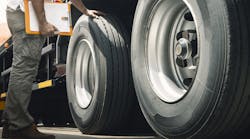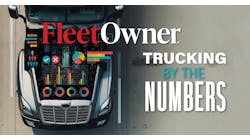Rohlwing: What trucking can learn about TPMS from the passenger experience
If you look at transportation over the last 40 years, there have been a lot of changes—and truck tires are no exception.
In the early 1980s, tube-type tires on multipiece rims were still quite common on most trucks. By the time the '90s rolled around, tubeless radial tires on single-piece rims became more dominant and, at the turn of the century, the 22.5-inch tubeless radial tire on a hub-pilot wheel was far and away the most common commercial assembly on the road. I believe the hub-pilot assembly qualifies as a sea change because it transformed the industry and continues to be the most popular truck tire and wheel configuration to this day.
In the early 2000s, tire pressure monitoring systems (TPMS) received a lot of attention after a highly publicized tire recall. The resulting legislation mandated a TPMS in every vehicle under 10,000 lb. gross vehicle weight rating starting with the 2008 models. Estimates from the National Highway Traffic Safety Administration showed that warning motorists of an underinflated tire saves 660 lives, prevents 33,000 injuries, and saves consumers $511 million in gasoline costs each year. For the passenger vehicle industry, TPMS has become standard and federally mandated.
TPMS was an absolute nightmare around 2008. Systems were manufacturer-specific, so there was limited interchangeability. Tooling needed to be changed every model year, so the TPMS tool everyone had to have in 2008 was obsolete by 2012. Motorists were so frustrated with the dashboard indicators that many resorted to black tape over the light in lieu of expensive repairs. It’s leveled out by now, but TPMS was a sea change that transformed passenger tire service.
TPMS adoption lessons for trucking
As trucking begins to voluntarily adopt TPMS, there are some lessons that can be learned from the past 20 years. In the early days, sensors were either attached to the valve stem or secured to the rim with a metal band. Valve-stem sensors were the most popular and when the rubber snap-in sensor hit the market, manufacturers had a low-cost and easy-to-install alternative to the metal clamp-in sensor, adding to their popularity. The band-mounted sensor was not widely embraced, and only one manufacturer was willing to use that approach on select models from 2006 to 2009. Since then, it has (thankfully) vanished from the market.
See also: Tire Tracks: Let's not overlook the value of valve stems
There were several operational challenges with band-mounted sensors that could not be overcome. First, the position of the sensor was supposed to be opposite the valve stem. When it moved, which it often did, unsuspecting technicians would break the sensors when unseating the beads because they couldn’t see inside the tire. Valve-stem sensors always stayed with the valve so they were easy to locate. Technicians broke them, too, but the industry eventually learned how to service tires and wheels without breaking valve-stem sensors in large numbers.
The bands themselves were also a challenge that could not be conquered. If it was a worm-gear, then proper torque was critical. Too much and it stripped and spun. Not enough and it just spun. If the band was crimped, insufficient force resulted in a similar outcome. More than one rim was scrapped as the result of a slipped band.
Additionally, the sensor was attached to a cradle that was secured to the metal band. If the sensor wasn’t properly attached or the clip that held it in place was damaged or broken, it would get loose inside the tire and do all kinds of damage. By the time it got to the technician, the sensor would be in pieces and the inner liner of the tire would be destroyed. Valve-stem sensors rarely get separated from the valve stem, so those problems generally are avoided.
Without a federal mandate, how TPMS is implemented in trucks will be determined by the market. Based on my experience since the start of placing sensors inside tires to monitor inflation pressure, fleets that select a band-mounted sensor will need to make sure that technicians are properly trained to mount tires and install the bands to avoid the problems of the past that led to their demise. Valve-stem sensors have similar challenges related to mounting and demounting, but again, they rarely get separated from the valve stem and cannot spin.
Only time will tell if TPMS creates a sea change for truck tire and wheel service, but early success will depend largely on the technicians who service the assemblies.



